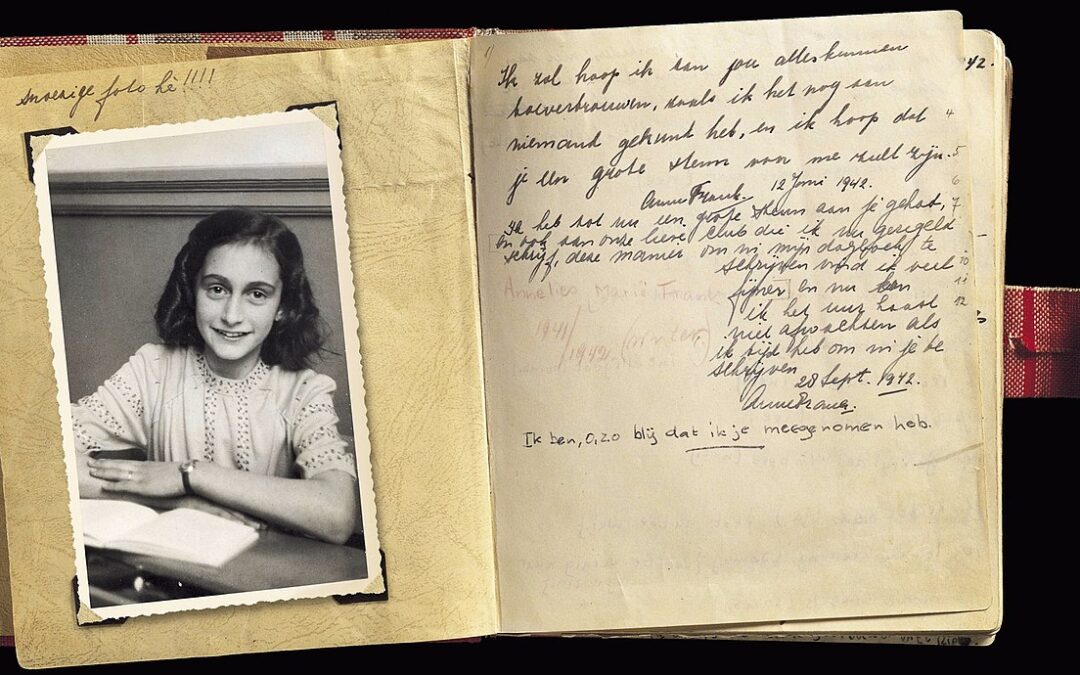Tragically, Anne Frank (born 1929) is perhaps the best-known Dutch writer. The diary she wrote during World War II has become a worldwide bestseller and is one of the most widely read books in the world. It gave a face to the Holocaust.
Her book ‘The Diary of a Young Girl’ is about her time in ‘het Achterhuis’ (the house in the back) in Amsterdam, which is located right next to the famous Westertoren. They lived there and hid during raids in a room hidden behind a bookcase. While staying in this house, Anne Frank started working on her diary, which she named ‘Kitty.’ She did this to give the misery of the war a place in her young life.
In 1944, the hiding place was discovered, probably by betrayal. It is still unclear who was responsible for this. She was deported to the Auschwitz-Birkenau extermination camp and later to concentration camp Bergen-Belsen. There, she died in 1945 as a result of typhoid fever.
Miep Gies
Only father Otto Frank survived the war. He received a stack of notebooks from Miep Gies, who had helped the family. It turned out that they were the diaries that Anne wrote. In 1947, the diary was published under the title Het Achterhuis.
America
The book soon became famous in several languages, but only really became world-famous after an American stage adaptation in 1955. It has been widely read and studied in schools across the country. The book has been translated into over 70 languages and has sold millions of copies worldwide, including in the United States. Additionally, there have been numerous adaptations of Anne Frank’s story for stage, film, and television, which have been seen by audiences in the United States and around the world. Overall, Anne Frank’s legacy has had a significant impact on American culture and society. Today, this ‘Anne Frank House’ is visited by more than a million people every year.
Impact
One example of Anne Frank’s impact on American culture is the establishment of the Anne Frank Center for Mutual Respect in New York City. The center was founded in 1959 and serves as a museum and educational institution dedicated to promoting Anne Frank’s message of tolerance and understanding. The center offers educational programs, exhibits, and resources for educators, students, and the general public. It also advocates for human rights and social justice issues and promotes Anne Frank’s legacy as a symbol of hope and resilience in the face of adversity. The center has had a significant impact on American society by raising awareness about the Holocaust and the importance of combating prejudice and discrimination.
Tree
In the garden of ‘het Achterhuis’ stood a chestnut tree that Anne overlooked. Cuttings of it were brought to America and can be seen in New York’s Liberty Park, as well as in the Holocaust museums in Washington and Michigan. A cutting has also been planted at Central High School in Little Rock. That city was the center of a major race riot in 1957 in which nine black students were refused entry to the school. With this initiative, the Anne Frank Center wants to keep the memory of Anne Frank alive and promote tolerance.
Excerpt of the diary of Anne Frank
Saturday, June 20, 1942
My father was 36 when he married my mother, who was then 25. My sister Margot was born in 1926. I
followed on June 12, 1929, and, as we are Jewish, we emigrated to Holland in 1933, where my father
was appointed Managing Director of Travies NV. This firm is in close contact with the firm Kolen and
Company in the same building, of which my father is a partner.
The rest of our family, however, felt the full impact of Hitler’s snit-Semitic laws, so life was filled with
anxiety. In 1938 after the pograms1
, my two uncles escaped to the USA. My old grandmother then came
to us, she was then 73. After May 1940, good times rapidly fled: first the war, then the surrender,
followed by the arrival of the Germans, which is when the suffering of the Jews really began.
Anti-Jewish decrees2
followed each other in quick succession. Jews must wear a yellow star. Jews must
hand in their bicycles. Jews are banned from trains and are forbidden to drive. Jews are only allowed to
do their shopping between three and five o’clock, and then only in shops which bear the placard “Jewish
Shop.” Jews must be indoors by eight o’clock and cannot even sit in their own gardens after that hour.
Jews are forbidden to visit theatres and other places of entertainment. Jews may not take part in public
sports, swimming baths, tennis courts, hockey fields, and other sports grounds are all prohibited to
them. Jews may not visit Christians. Jews must go to Jewish schools, and many more similar restrictions.
So we could not do this and we were forbidden to do that. Jopie3
used to say to me, “You’re scared to
do anything because you fear it may be forbidden.” Our freedom was strictly limited. Yet things were
still bearable

Marcel Beijer is a Dutch writer who published his book Golden Mountains on Amazon. Read more about it here
It is available here.
